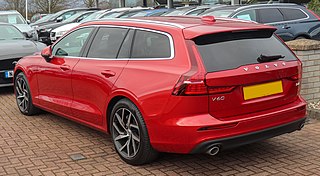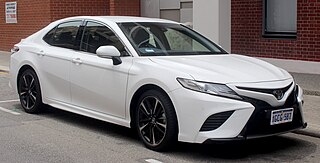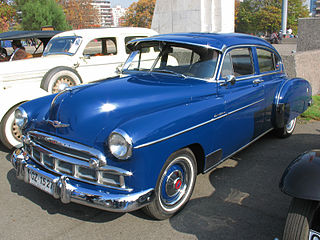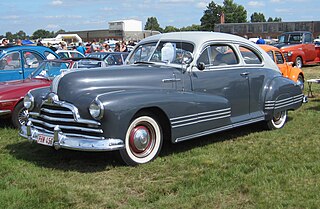
A station wagon or estate car, is an automotive body-style variant of a sedan with its roof extended rearward over a shared passenger/cargo volume with access at the back via a third or fifth door, instead of a trunk/boot lid. The body style transforms a standard three-box design into a two-box design—to include an A, B, and C-pillar, as well as a D-pillar. Station wagons can flexibly reconfigure their interior volume via fold-down rear seats to prioritize either passenger or cargo volume.

A hatchback is a car body configuration with a rear door that swings upward to provide access to the main interior of the car as a cargo area rather than just to a separated trunk. Hatchbacks may feature fold-down second-row seating, where the interior can be reconfigured to prioritize passenger or cargo volume.

A sedan or saloon is a passenger car in a three-box configuration with separate compartments for an engine, passengers, and cargo. The first recorded use of sedan in reference to an automobile body occurred in 1912. The name derives from the 17th-century litter known as a sedan chair, a one-person enclosed box with windows and carried by porters. Variations of the sedan style include the close-coupled sedan, club sedan, convertible sedan, fastback sedan, hardtop sedan, notchback sedan, and sedanet/sedanette.

The Volkswagen Type 3 is a compact car manufactured and marketed by Volkswagen from 1961 to 1973. Introduced at the 1961 Frankfurt International Motor Show, the IAA, the Type 3 was marketed as the Volkswagen 1500 and later as the Volkswagen 1600, in two-door Notchback, Fastback, and Variant body styles, the latter marketed as the 'Squareback' in the United States.

The Ambassador is an automobile manufactured and marketed by American Motors Corporation (AMC) from 1957 through 1974 over eight generations, available in two- and four-door sedan, two-door hardtop, four-door station wagon as well as two-door convertible body styles. It was classified as a full-size car from 1957 through 1961, mid-size from 1962 until 1966, and again full-size from 1967 through 1974 model years.

A fastback is an automotive styling feature, defined by the rear of the car having a single slope from the roof to the tail. The kammback is a type of fastback style.

A liftback is a variation of a hatchback car body style, with a more gently sloping roofline, roughly between 45 and 10 degrees, whereas traditional or archetypal hatchback designs tend to use a 45 degree to near vertical slope on the top-hinged tailgate.

The Oldsmobile Series 70 is a full-size midrange automobile produced by Oldsmobile between the 1939 and 1950 model years. Oldsmobiles of this time period were in an unusual "middle" position in GM's hierarchy of automobile brands. Chevrolet and Pontiac were the budget priced models, while Buick and Cadillac were the luxury brands. GM would share their "A" body platforms between Chevrolet, Pontiac, and "B" body on Oldsmobile and Buick, while leaving Cadillac on the senior "C" platform. Oldsmobiles were then branded as "luxury level" Chevrolet's and Pontiac's, while Oldsmobiles using the "B" platform were "budget priced" Buicks and Cadillacs.

The Buick Roadmaster is an automobile that was built by Buick from 1936 until 1942, from 1946 until 1958, and then again from 1991 until 1996. Roadmasters produced between 1936 and 1958 were built on Buick's longest non-limousine wheelbase and shared their basic structure with the entry-level Cadillac Series 65, the Buick Limited, and after 1940, the Oldsmobile 98. Between 1946 and 1957 the Roadmaster served as Buick's flagship.

The Cadillac Sixty Special is a name used by Cadillac to denote a special model since the 1938 Harley Earl–Bill Mitchell–designed extended wheelbase derivative of the Series 60, often referred to as the Fleetwood Sixty Special. The Sixty Special designation was reserved for some of Cadillac's most luxurious vehicles. It was offered as a four-door sedan and briefly as a four-door hardtop. This exclusivity was reflected in the introduction of the exclusive Fleetwood Sixty Special Brougham d'Elegance in 1973 and the Fleetwood Sixty Special Brougham Talisman in 1974, and it was offered as one trim package below the Series 70 limousine. The Sixty Special name was temporarily retired in 1976 but returned again in 1987 and continued through 1993.

The Cadillac Series 61 was Cadillac's mainstream product model range. It was priced and equipped more modestly below the limousine, GM D platform Cadillac Series 85, Cadillac Series 90, Cadillac Series 72, Cadillac Series 67, and Cadillac Fleetwood Series 75. It was upgraded to the Series 62 in 1940 only to return to production in model year 1941, replacing the cancelled LaSalle Series 50. While production was suspended from model years 1943–1945 due to World War II, it remained as the junior level product line until 1951. The size, equipment list and quality level were the most popular with buyers who wanted a prestigious luxury car that was usually driven by the owner, while the longer cars were chauffeur driven. It combined the most popular features of the previous Series 60 and Series 65 and was priced at the same level as Buick products of the time.

The configuration of a car body is typically determined by the layout of the engine, passenger and luggage compartments, which can be shared or separately articulated. A key design feature is the car's roof-supporting pillars, designated from front to rear of the car as A-pillar, B-pillar, C-pillar and D-pillar.

The Rambler Tarpon was a concept car, a compact-sized sporty youth-oriented 2+2 hardtop coupé developed in 1963 by American Motors Corporation (AMC). The bright red with black roof design study made its public debut 1964 Chicago Auto Show and served to foretell the fastback design elements of the larger Rambler Marlin that was introduced in 1965.

A brougham was originally a car body style where the driver sat outside and passengers seated within an enclosed cabin, — deriving the configuration from the earlier brougham horse-drawn carriage. Similar in style to the later town car, the brougham style was used on chauffeur-driven petrol and electric cars.

The Chevrolet Special Deluxe Series AH Fleetline was an automobile produced by US automaker Chevrolet from 1941 to 1952. From 1946 to 1948 it was a sub-series of the Chevrolet Fleetmaster rather than a series of the Special Deluxe and, from 1949 to 1951, it was a sub-series of both the Chevrolet Special and the Chevrolet Deluxe. In its final year it was offered only as a sub-series of the latter.

The Chevrolet Deluxe is a trim line of Chevrolet automobiles that was marketed from 1941 to 1952, and was the volume sales leader for the market during the 1940s. The line included at first a 4-door sedan, but grew to include a fastback 2-door "aerosedan" and other body styles. The 1941 Chevrolet was the first generation that didn't share a common appearance with Chevrolet trucks, while the Chevrolet AK Series truck did share common internal components.

The Cadillac DeVille is the nameplate used by Cadillac over eight generations, originally used to designate a trim level of the 1949 Cadillac Series 62 and later to designate a standalone model in the brand range. The last model marketed specifically as a DeVille was the 2005 full-size sedan, at the time, Cadillac's largest model.

The Pontiac Torpedo was a full-sized car produced by Pontiac from the 1940 through the 1948 model year. When released, it was the biggest Pontiac, used an 8-cylinder engine, and it had more standard features than other Pontiacs. Although the Torpedo name was exclusive to the highest line of Pontiacs in 1940, in 1941 the name was applied to all Pontiacs in three separate lines. The Custom Torpedoes were now top-of-the-line name, while the DeLuxe Torpedo became the base line, and the Streamline Torpedo became the middle line of Pontiacs. All Torpedo models could be had with either a 6-cylinder or 8-cylinder engine beginning in 1941. From 1942 to 1948 the Torpedo name designated only the base line of Pontiacs. The Torpedo was replaced by the Pontiac Chieftain in 1949. It was with this generation that all GM vehicles experienced increased width dimensions to accommodate three passengers on the front bench seat and an additional three passengers on rear bench seat installed vehicles. This was accomplished with the deletion of running board thereby adding additional room inside the passenger compartment.

The Pontiac Streamliner is a full-size car produced under the Pontiac brand by General Motors from 1932 until 1952. A mass-produced and popular vehicle, it was a significant luxury car during the recovery from the Great Depression, and during and immediately after the Second World War.























